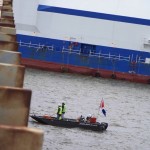Austin Ramsey
News Editor

Officials with the Kentucky Transportation Cabinet and the U.S. Coast Guard are hastening to provide answers and solutions after an ocean-going freight ship struck the Eggner’s Ferry Bridge over the Kentucky Lake Thursday, Jan. 26.
The Delta Mariner, 312-foot long transcontinental vessel struck the bridge at around 8 p.m., causing a 322-foot segment of the bridge to come crashing on its bow.
Immediate responders included the Aurora (Ky.) Fire Department and the Marshall County Rescue Squad. Those agencies determined no cars had gone off the bridge platform with the debris.
Today, the ship sits dormant along the shores of the lake, with the crumpled wreckage of the bridge still on top of it and a crane standing at a tall attention on the western bank. Emergency services have long gone, and concrete dividers support the nearly 2,800-cars-a-day traffic the bridge is used to carrying along U.S. 68/Ky. Hwy. 80.
Keith Todd, a spokesperson for the KTC said the remainder of the bridge, the water around it and the ship and its crew are now under a thorough investigation by the Coast Guard and the National Transportation Safety Board.

But while that investigation ensues, Todd said it is the KTC’s job to ensure the stability of the bridge as it now stands. Immediately after the boat hit, agency vehicles packed the remaining sides of the structure, but that roadway has since been vacated and the stability of pier six on the eastern portion of the bridge has been questioned.
Guardrails along that portion of the bridge were reported to have sustained some buckling since the ship’s impact, Todd said.
“We’re not sure that the crook in that guardrail is due to the impact at this point. That’s something we’re still evaluating,” he said.
A bridge inspection dive team attached sensors to the submerged portion of pier six as well as piers five and seven, and Todd said he hopes to have a report back from the team by early next week.
“If that pier is moving, that’s something of a game changer in that if that pier is solid, then that gives us a working point to go in and replace the missing span,” he said. “If that pier is moving, then we’re going to have to take a step back and it’s going to require more work.”
Pending on the swift removal of the ship from the shores adjacent the bridge, the KTC is evaluating possible measures to restore the heavy traffic flow in the area.
One solution Todd mentioned was a ferry, but he said he is concerned about whether a ferry service could transport thousands of vehicles a day. Repairing the two missing spans is also on the table, but the stability of the eastern portion of the bridge could dampen that effort.
The final idea is to quicken the building process of a new bridge, which already went through planning, designing and drilling stages. Construction of that bridge was slated to begin by 2014, but even if it began sooner, Todd said it would be years before it was completed.
He said he would like to see a combination of two of the ideas, or see more come to the table, so that the negative ramifications the slowed traffic has had on the region can be reversed.
Todd said companies experienced with bridge repair and replacement have approached the state to help with the upcoming process.
“There are a lot of resources out there that are available to us, and it’s going to be a matter of figuring out which one works the best in this instance,” he said.
The Marshall County Sheriff’s office announced Sunday that citations would be issued to people who went out onto the bridge. That morning, the KTC reported several hundred people on the bridge at one time.
Todd said people should avoid the bridge, as its safety could still be called into question.
“That boat is rated at 8,400 tons,” he said. “When you have an object that large hitting something as massive as a bridge, the force at work there – required to bring those spans down – those forces are just really incredible. So, that’s the reason we’re keeping people off the bridge.”
Following the collapse, investigators came under a hail of questions regarding the lighting on the bridge when the ship hit it.
The company that owns the Delta Mariner – Ross Maritime Inc. – claimed this week the state was at fault for the accident, as navigational lights on the south side of the bridge were not operational when the ship approached.
Mike Hancock, state secretary of education rebutted the marine corporation early this week at a press conference in Frankfort, saying the freighter’s navigational equipment should have warned the ship’s pilot that the portion of the bridge under which he was trying to pass was not tall enough for the Delta Mariner’s 50-foot sitting height.
Lt. Ron Easley, with the Coast Guard, said investigators were taking all of these factors into account with an investigation both of the lights on the bridge and the boat’s equipment.
“In the rivers, it’s different from open ocean water; you have a lot of factors,” he said. “Wind can play a major part, current can play a part and so can the water levels. But (lighting) can be a factor for any incident.”
Easley said the ship was also traveling along the auxiliary channel, nearly 483 feet from the main channel, where it would have cleared the bottom of the bridge.
Neither the KTC, Coast Guard, NTSB, nor Ross Maritime Inc. could account for why the ship had steered so far off course.
The Delta Mariner was on a 2,100-mile trip from Decatur, Ala., to Cape Canaveral, Fla., carrying Boeing Atlas V and Delta rocket components for NASA. The ship is capable of carrying up to 160-foot-long Delta IV common booster cores.




























































































